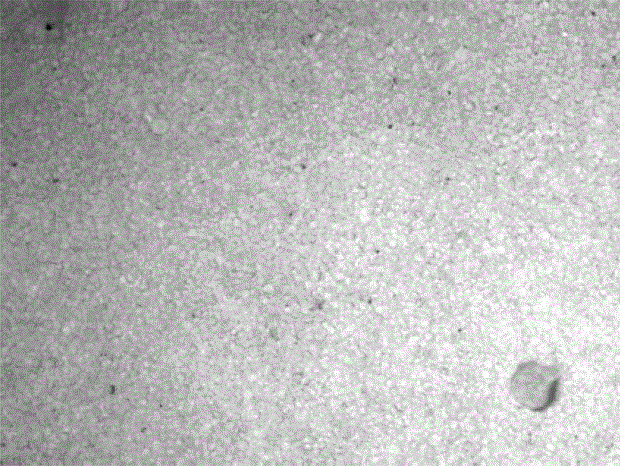Method for detecting cells from a sample
A cell and sample technology, applied in the field of detecting cells from samples, can solve problems such as the importance not mentioned
- Summary
- Abstract
- Description
- Claims
- Application Information
AI Technical Summary
Problems solved by technology
Method used
Image
Examples
Embodiment 1
[0068] Legionella in drinking water ( Legionella ) for fluorescence detection.
[0069] 1. Functionalization of PTFE membrane and antibody immobilization.
[0070] In the first step, PTFE membranes hydrophilized by OH groups (OMNIPOREJC from Millipore) were aminated by treatment with 3-aminopropyltriethoxysilane (APTS). Therefore, 50 μl of 3-aminopropyltriethoxysilane (Sigma-Aldrich Chemie GmbH) was dissolved in 4950 μl of acetone and applied to the dried membrane (d=5 cm) in a 90 mm glass Petri dish. The dishes were transferred to a glass desiccator which was rapidly (<10 min) evacuated to <300 mbar. Incubate for 12 hours at room temperature at 20 rpm on an orbital shaker in a closed desiccator. Subsequently, 0.42 μl of reagent grade 37% hydrochloric acid (Carl Roth GmbH & Co. KG) was added. The dishes were then transferred to a glass desiccator which was rapidly (<10 min) evacuated to <300 mbar. Then incubate for 6 hours at room temperature at 20 rpm on an orbital shak...
Embodiment 2
[0082] Via HRP / TMB prec. Drinking water tested Legionella Detection of bacteria.
[0083] 1. Antibody immobilization on HDPE membrane.
[0084] In a first step, anti- Legionella Antibodies (5F4, Senova, Weimar) were immobilized by physisorption on HDPE membranes (Porex Inc. type T3, pore size 5-10 μm, thickness 200 μm, high density polyethylene = HDPE). Therefore, 50 round filters (d=5 mm) were punched out and placed in a 50 ml beaker with 20 ml ethanol (96%) and degassed in a desiccator at 10 Torr, on a magnetic stirrer Stir gently for 20 min. Subsequently, the filter was washed with 50% ethanol solution and finally degassed three times in 10 ml of carbonate buffer (100 mM, pH 9.5). Subsequently, 100 μl of 1 mg / ml anti- Legionella solution. The filters were incubated in a desiccator for 6 hours at room temperature with gentle agitation. Subsequently, the antibody solution was replaced with a block solution (5.5 mg / ml casein dissolved in PBS buffer (150 mM, pH=7.3))...
Embodiment 3
[0090] by vital staining on a hyaline membrane Salmonella Bacteria detection.
[0091] 1. Immobilization of antibodies.
[0092] The membrane according to item 1 of example 1 was used. Instead of the antibody used therein, monoclonal anti- Salmonella Bacteria antibody (1E6, SifinGmbH, Berlin) was immobilized on the membrane.
[0093] 2. Preparation of the filter assembly.
[0094] A circular filter with a diameter of 24 mm was punched out of the membrane using a hole punch. The filter was fixed to the bottom of an empty 20 ml column with an insertable bottom (SpinColumn, AHNBiotechnology, Nordhausen, Germany). A peristaltic pump was connected to the lower luer port of the column.
[0095] 3. Sample preparation.
[0096] 25g of heat-sterilized meat samples and 225ml of buffered peptone water were added to the inner filter bag of a Stomacherbag (BA6141 / STR, SewardLimited, UK), and 10 μl of Salmonella typhimuria (ATCC14028) pre-culture (1000germs / ml) incubation. The sam...
PUM
| Property | Measurement | Unit |
|---|---|---|
| thickness | aaaaa | aaaaa |
| length | aaaaa | aaaaa |
| width | aaaaa | aaaaa |
Abstract
Description
Claims
Application Information
 Login to View More
Login to View More - R&D
- Intellectual Property
- Life Sciences
- Materials
- Tech Scout
- Unparalleled Data Quality
- Higher Quality Content
- 60% Fewer Hallucinations
Browse by: Latest US Patents, China's latest patents, Technical Efficacy Thesaurus, Application Domain, Technology Topic, Popular Technical Reports.
© 2025 PatSnap. All rights reserved.Legal|Privacy policy|Modern Slavery Act Transparency Statement|Sitemap|About US| Contact US: help@patsnap.com



